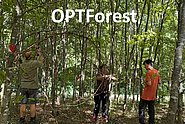Genetische Vielfalt ist Grundvoraussetzung dafür, dass sich Arten an sich ändernde Umweltbedingungen wie den Klimawandel anpassen und gegenüber extremen Umweltereignissen resilient sind. Bei der künstlichen Verjüngung zukunftsfähiger Baumbestände sollte deshalb genetisch vielfältiges Vermehrungsgut (Saat- und Pflanzgut) verwendet werden. Die Beerntung von Saatgut erfolgt heute jedoch aus Effizienz- und Kostengründen häufig opportunistisch und nicht mit dem Ziel, eine hohe genetische Vielfalt zu erreichen. Die Anpassungsfähigkeit des gesammelten Saatguts könnte dadurch eingeschränkt sein. Mit molekulargenetischen Analysen von 216 ( potenziellen) Mutterbäumen und 1037 Eicheln untersuchten wir in je einem Samenerntebestand für Stielund Traubeneiche, wie sich die Samenerntestrategie auf die neutrale, nicht fitness-relevante genetische Vielfalt des Saatguts auswirkt. Unsere Resultate zeigen, dass die genetische Vielfalt des Saatguts vor allem von der Anzahl Mutterbäume und Eicheln pro Mutterbaum abhängt. Bereits 100 Eicheln reichten, um fast die gesamte genetische Vielfalt aller Eicheln eines Mutterbaumes zu sammeln, was mit der gängigen Samenerntepraxis gegeben ist. Um 75–95% der totalen genetischen Vielfalt eines Samenerntebestandes zu erreichen, waren 19–43 Mutterbäume notwendig – also deutlich mehr als in der Praxis üblich. Die Samenernte in verschiedenen Sektoren (Waldabschnitten) und die Vermeidung von nahe gelegenen Halbgeschwistern hatten hingegen einen geringen Einfluss. Zusammenfassend sollte sich die Samenernte also auf eine möglichst hohe Anzahl Mutterbäume fokussieren, was bei den Eichen mit kleinem finanziellem Aufwand möglich ist. Wegen der Anpassung an kleinräumige Standorteigenschaften würde sich die Samenernte in mehreren Sektoren aber wohl lohnen, wenn sich diese hinsichtlich ihrer ökologischen Eigenschaften unterscheiden. Diese Erkenntnisse unterstreichen die Notwendigkeit von praktischen Hinweisen und Richtlinien zur Optimierung der Samenernte. Zudem sind sie eine nützliche Grundlage für die strategische Planung von Baumschulen und tragen zur Anpassungsfähigkeit unserer Baumarten und zur Resilienz des zukünftigen Waldes bei.
See DOISee Institutional Repository




